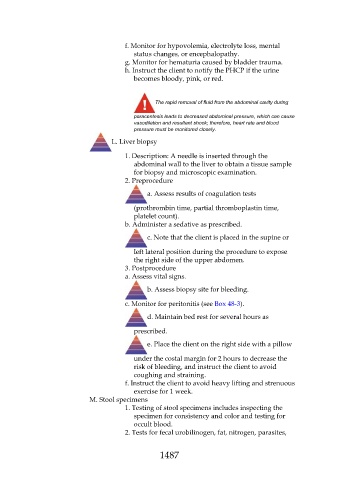Page 1487 - Saunders Comprehensive Review For NCLEX-RN
P. 1487
f. Monitor for hypovolemia, electrolyte loss, mental
status changes, or encephalopathy.
g. Monitor for hematuria caused by bladder trauma.
h. Instruct the client to notify the PHCP if the urine
becomes bloody, pink, or red.
The rapid removal of fluid from the abdominal cavity during
paracentesis leads to decreased abdominal pressure, which can cause
vasodilation and resultant shock; therefore, heart rate and blood
pressure must be monitored closely.
L. Liver biopsy
1. Description: A needle is inserted through the
abdominal wall to the liver to obtain a tissue sample
for biopsy and microscopic examination.
2. Preprocedure
a. Assess results of coagulation tests
(prothrombin time, partial thromboplastin time,
platelet count).
b. Administer a sedative as prescribed.
c. Note that the client is placed in the supine or
left lateral position during the procedure to expose
the right side of the upper abdomen.
3. Postprocedure
a. Assess vital signs.
b. Assess biopsy site for bleeding.
c. Monitor for peritonitis (see Box 48-3).
d. Maintain bed rest for several hours as
prescribed.
e. Place the client on the right side with a pillow
under the costal margin for 2 hours to decrease the
risk of bleeding, and instruct the client to avoid
coughing and straining.
f. Instruct the client to avoid heavy lifting and strenuous
exercise for 1 week.
M. Stool specimens
1. Testing of stool specimens includes inspecting the
specimen for consistency and color and testing for
occult blood.
2. Tests for fecal urobilinogen, fat, nitrogen, parasites,
1487

